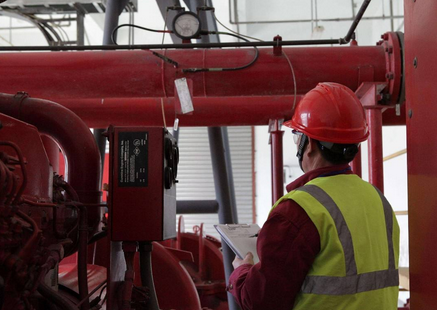Fire pump inspection items
The inspection items of fire pumps cover many aspects to ensure that they work properly and can provide fire-fighting water in a timely and effective manner when a fire occurs. The following are the main items for fire pump inspection:
1. Mechanical part inspection
Pump body inspection:
Observe whether the pump body has abnormal phenomena such as deformation, cracks, rust, etc.
Check whether the markings on the pump body are clear and complete, including product name, model, rated flow, head, etc.
Pump shaft and bearing inspection:
Check whether the pump shaft has abnormal phenomena such as bending and cracks.
Check whether the connection between the pump shaft and the motor is tight and the coaxiality is good.
Check whether the appearance of the bearing has abnormal phenomena such as wear and pitting, and whether the lubrication is good.
Impeller inspection:
Check whether the impeller is worn and whether it needs to be replaced or repaired.
Seal ring inspection:
Check whether the appearance of the seal is damaged, aging, etc., and whether the seal and the pump shaft are tightly matched to prevent water leakage.

2. Electrical part inspection
Motor inspection:
Check whether the appearance of the motor is damaged, deformed, etc.
Check whether the power cord of the motor is intact and the terminal is tight.
Check whether the grounding device of the motor is reliable.
Control system inspection:
Check the control system of the water pump, including the start button, stop button, operation indicator light, etc., to ensure that each part functions normally and can respond to operations quickly.
Cable and terminal board inspection:
Check whether the cable is intact and whether there are problems such as short circuit and leakage.
Check whether the terminal board is firmly connected and not loose or damaged.
3. Water pipe system inspection
Pipeline inspection:
Check whether the pipeline is damaged or deformed.
Check whether the connection of the pipeline is tight to prevent water leakage.
Check whether the direction of the pipeline is reasonable to avoid excessive bends affecting the water flow.
Valve inspection:
Check whether the valve is opened or closed normally without jamming.
Check whether the valve is leaking.
Pump box inspection:
Check whether the pump box is damaged or aging.
Check whether the water level in the pump box is normal and whether the water quality is clean.
4. Performance test
Flow test:
Use a flow meter to accurately measure the water flow rate of the pump per minute, and compare it with the design specifications to verify whether the water flow output of the pump meets the requirements.
Pressure test:
Use a pressure gauge to measure the outlet pressure of the water pump to ensure that it is within the normal operating range.
Also check the pressure gauge in the fire protection system to ensure that it is also in normal working condition.
Operation stability test:
By continuously running the water pump for a period of time, observe the stability of its operating state.
Check for abnormal conditions such as abnormal noise, vibration or excessive temperature.
Cold start and hot start test:
Cold start test: Start the water pump at room temperature to verify the reliability of the starting process.
Hot start test: Simulate the sudden stop of the water pump after a certain period of operation, and then quickly restart it to ensure that the water pump can start quickly from the stopped state in a short time.
V. Other tests
Insulation resistance test: Check whether the insulation resistance of the motor meets the safety standards.
Vibration test: Detect the vibration of the water pump during operation to evaluate its mechanical properties and stability.
Noise measurement: Measure the noise level of the water pump during operation to ensure that it is within an acceptable range.




